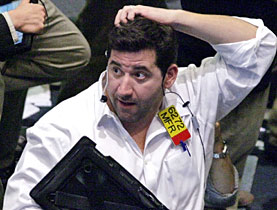Brain specialists look into risky business

Researchers in Switzerland and the United States have announced an important neurological discovery in understanding how people predict and respond to risk.
They say the findings, published in the Journal of Neuroscience, will eventually help the financial world develop more reliable models for predicting market activity.
According to Peter Bossaerts, professor at the Federal Institute of Technology in Lausanne, there are marked differences between how the brain calculates risk and how financial markets calculate risk.
Bossaerts and his colleagues have been investigating the role that emotions play in this process.
They believe that when the brain calculates risk, it not only takes into account past errors in judgment, but that its internal algorithm is also more sensitive to rare events – the ones many financial models do not predict.
The disjuncture between the way brains calculate risk and computers calculate risk may, in large part, be the culprit behind the latest round of market turmoil – the type bedevilling shareholders every ten to 20 years.
Events labelled “unpredictable” by some in the finance realm – the ongoing subprime crisis as case-in-point – actually could be predicted, providing appropriate models are used, says Bossaerts. He notes the role that human emotions play when meticulously planned financial models err.
“When something bad happens in the markets, people just switch off their computers. The models are thrown out the window,” Bossaerts told swissinfo.
The crux of the matter, he said, is discovering the algorithm used by the human brain to assess risk. From there, researchers will be able to look at existing tools and fill the gap.
Understanding the brain
Research into how the brain deals with risk is not uncomplicated and until recently it would not have been the domain of Bossaerts, a financial specialist.
But in the past ten years, people like Bossaerts and his colleagues at leading universities in Britain, the US and Japan have built important cross-disciplinary bridges between the domains of neurology, risk and financial markets.
In the latest round of research – and in a project five years in the works – Bossaerts and his associates have delved deep into the brain.
Building on research into the sources of emotion, they have discovered that in large part, human response to risk is determined by activity in a rarely studied area known as the insula cortex.
In particular, it is the early activation of the front part – known as the anterior cortex and discovered through the use of functional imagining – that has piqued the interest of scientists.
They now believe – as seems to be consistently demonstrated on the floors of the world’s major exchanges – that emotions like euphoria are linked to the irrational underestimating of risk.
Conversely, people who predict that things are riskier than they actually are can be more susceptible to feelings such as anxiety.
Smarter bets
According to a statement released by Bossaerts’ Laboratory for Decision Making under Uncertainty, there has been little investigation into how the insula cortex influences errant decision-making.
But in understanding how individuals deal with risk, scientists and finance professionals will be able to compensate for what the human brain cannot do on its own.
“Rare events [as defined by conventional terms] are not rare in financial markets,” Bossaerts explained, and added that while conventional models may be “very good” they cannot produce a forecast without risk.
According to Bossarts, margins of error can be enormous and he cautions would-be financial whizzes to apply an extra layer of scrutiny to their calculations.
swissinfo, Justin Häne
Seven Swiss cities are participating in the 11th International Brain Awareness Week, which runs from March 10-16.
Organisers provided an overview of some of the organ’s main functions. The brain analyses data from external stimuli, controls feelings and coordinates behaviour. It also ensures that other physiological systems vital to staying alive – the respiratory, circulatory and food intake systems – function properly.
Nearly 2,000 schools and universities as well as civil and professional institutions from 62 countries are participating in the event.
In Switzerland, the cities of Aarau, Basel, Bern, Fribourg, Geneva, Lausanne and Zurich are taking part.
Peter Bossaerts, recently joined the Federal Institute of Technology in Lausanne as a professor. His field, neuro-finance, melds finance theory with neurology.
He was formerly a professor of economics and management as well as professor of finance at the California Institute of Technology (Caltech) and a research fellow at the Centre for Economic Policy Research in London.
The professor has distinguished himself through his scientific contribution to general finance and through his expertise in financial asset allocation theory, business management and behavioural finance.

In compliance with the JTI standards
More: SWI swissinfo.ch certified by the Journalism Trust Initiative











You can find an overview of ongoing debates with our journalists here . Please join us!
If you want to start a conversation about a topic raised in this article or want to report factual errors, email us at english@swissinfo.ch.